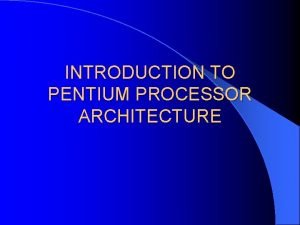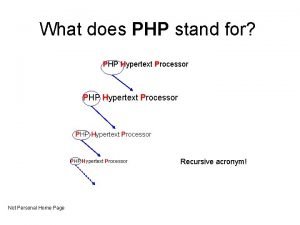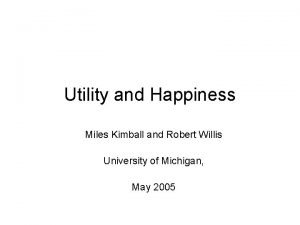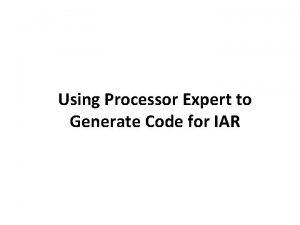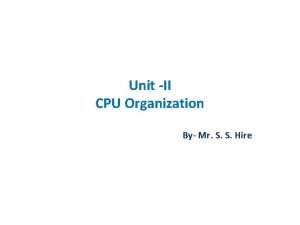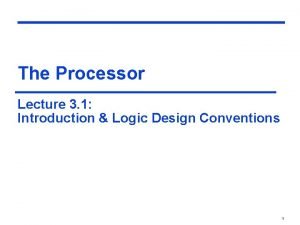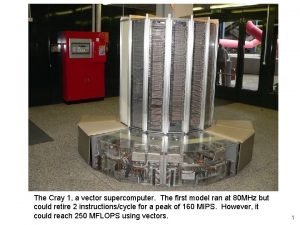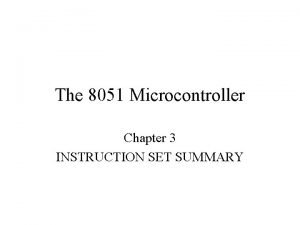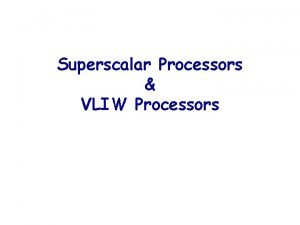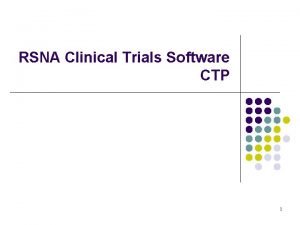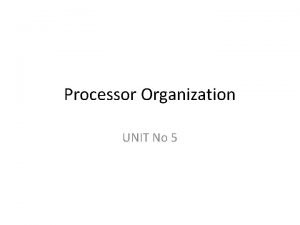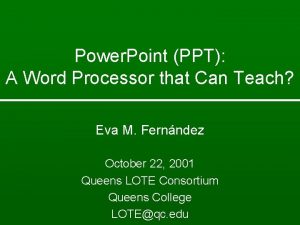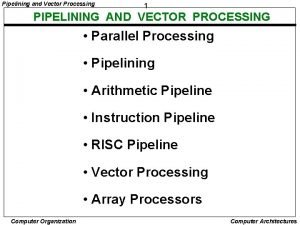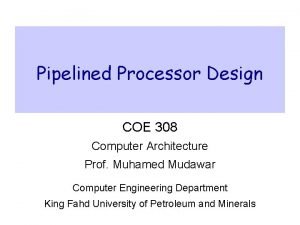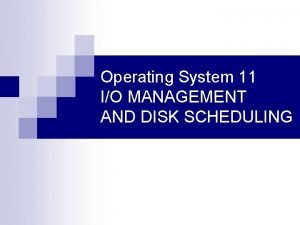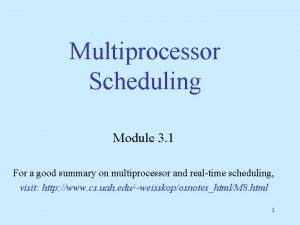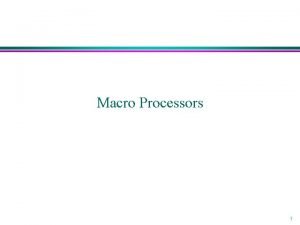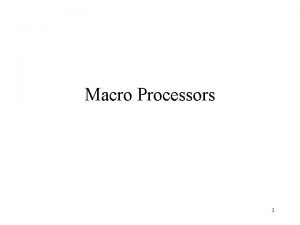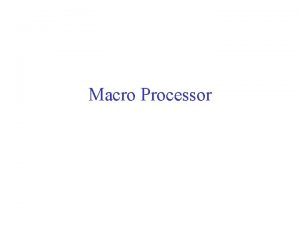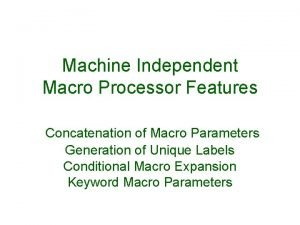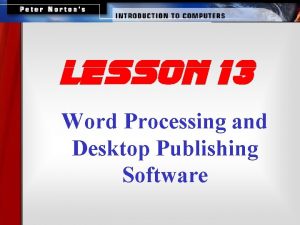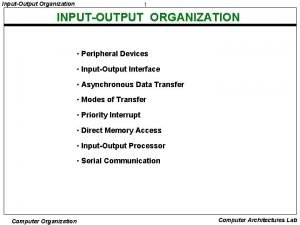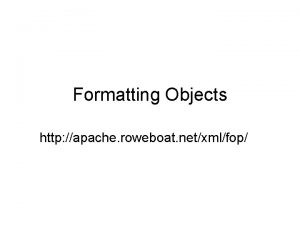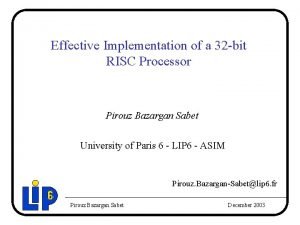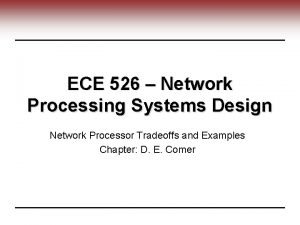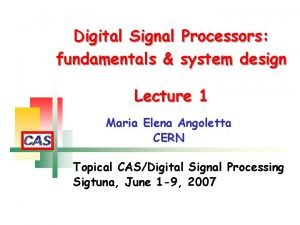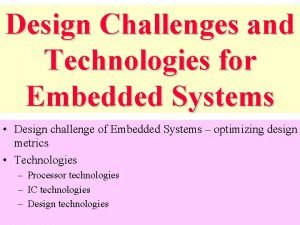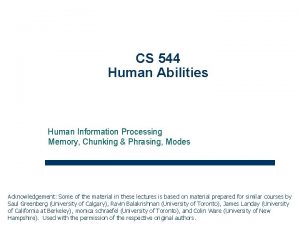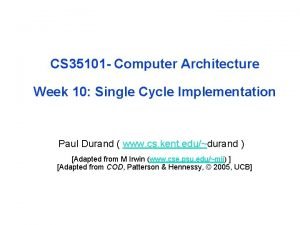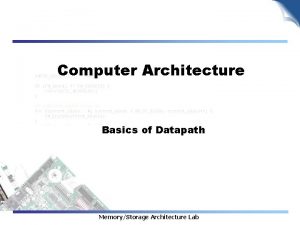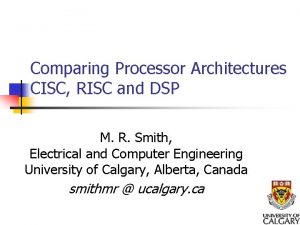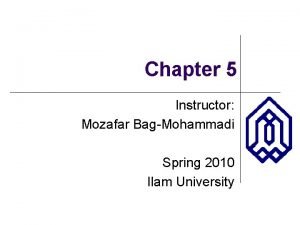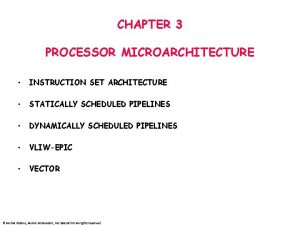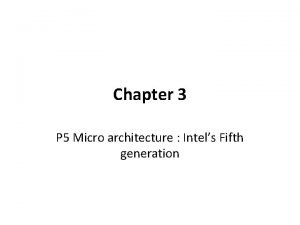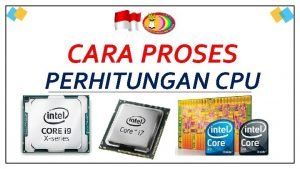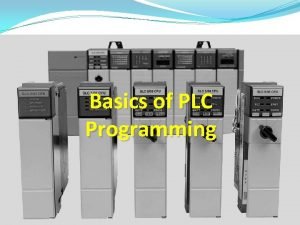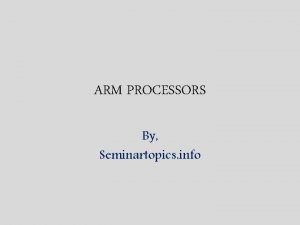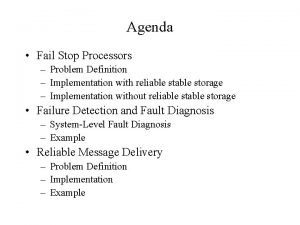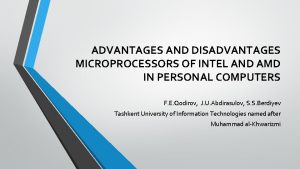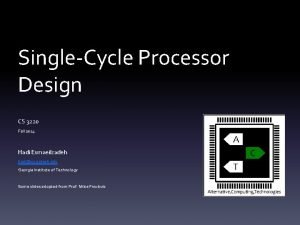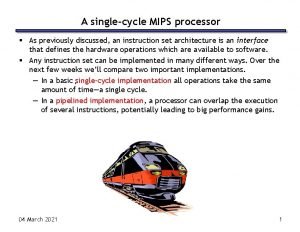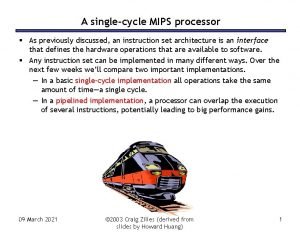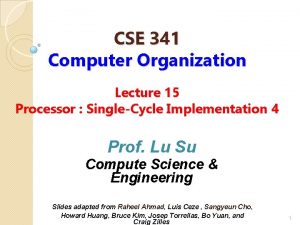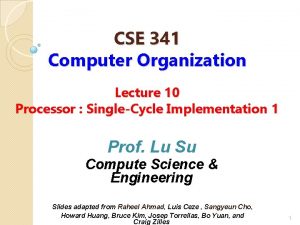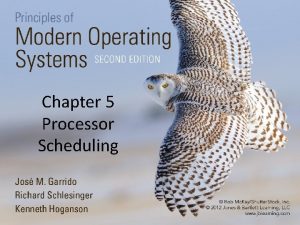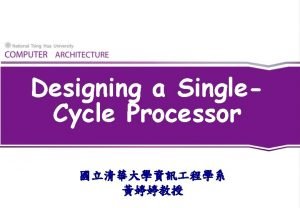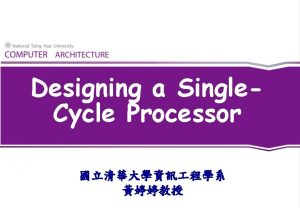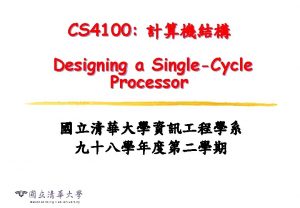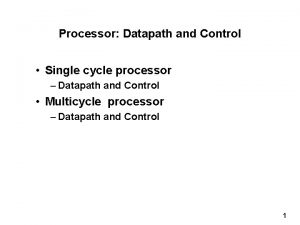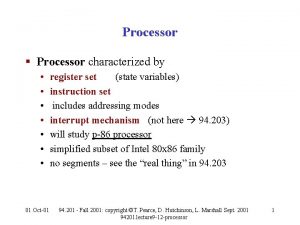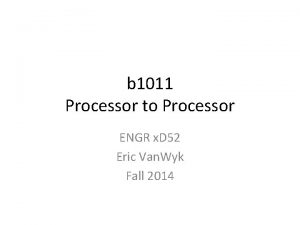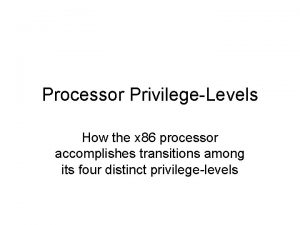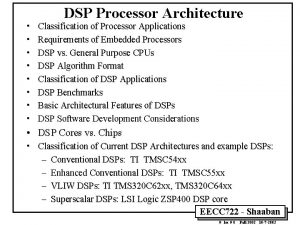Designing a SingleCycle Processor Outline Introduction to designing
























![Step 3 b: Add and Subtract • R[rd] <- R[rs] op R[rt] Ex: add Step 3 b: Add and Subtract • R[rd] <- R[rs] op R[rt] Ex: add](https://slidetodoc.com/presentation_image_h2/80ade727e9a52672ae645b578eed9971/image-25.jpg)
![Step 3 c: Store/Load Operations • R[rt]<-Mem[R[rs]+Sign. Ext[imm 16]] Ex: lw rt, rs, imm Step 3 c: Store/Load Operations • R[rt]<-Mem[R[rs]+Sign. Ext[imm 16]] Ex: lw rt, rs, imm](https://slidetodoc.com/presentation_image_h2/80ade727e9a52672ae645b578eed9971/image-26.jpg)

![Step 3 d: Branch Operations • beq rs, rt, imm 16 mem[PC] Fetch inst. Step 3 d: Branch Operations • beq rs, rt, imm 16 mem[PC] Fetch inst.](https://slidetodoc.com/presentation_image_h2/80ade727e9a52672ae645b578eed9971/image-28.jpg)











![Designing Main Control • Some observations: • opcode (Op[5 -0]) is always in bits Designing Main Control • Some observations: • opcode (Op[5 -0]) is always in bits](https://slidetodoc.com/presentation_image_h2/80ade727e9a52672ae645b578eed9971/image-40.jpg)


![Instruction Fetch at Start of Add • instruction <- mem[PC]; PC + 4 Instruction Fetch at Start of Add • instruction <- mem[PC]; PC + 4](https://slidetodoc.com/presentation_image_h2/80ade727e9a52672ae645b578eed9971/image-43.jpg)

![ALU Operation during Add • R[rs] + R[rt] ALU Operation during Add • R[rs] + R[rt]](https://slidetodoc.com/presentation_image_h2/80ade727e9a52672ae645b578eed9971/image-45.jpg)
![Write Back at the End of Add • R[rd] <- ALU; PC <- PC Write Back at the End of Add • R[rd] <- ALU; PC <- PC](https://slidetodoc.com/presentation_image_h2/80ade727e9a52672ae645b578eed9971/image-46.jpg)
![Datapath Operation for lw • R[rt] <- Memory {R[rs] + Sign. Ext[imm 16]} Datapath Operation for lw • R[rt] <- Memory {R[rs] + Sign. Ext[imm 16]}](https://slidetodoc.com/presentation_image_h2/80ade727e9a52672ae645b578eed9971/image-47.jpg)
![Datapath Operation for beq if (R[rs]-R[rt]==0) then Zero<-1 else Zero<-0 if (Zero==1) then PC=PC+4+sign. Datapath Operation for beq if (R[rs]-R[rt]==0) then Zero<-1 else Zero<-0 if (Zero==1) then PC=PC+4+sign.](https://slidetodoc.com/presentation_image_h2/80ade727e9a52672ae645b578eed9971/image-48.jpg)














- Slides: 62

Designing a Single-Cycle Processor

Outline • Introduction to designing a processor • Analyzing the instruction set • Building the datapath • A single-cycle implementation • Control for the single-cycle CPU • Control of CPU operations • ALU controller • Main controller

Introduction • CPU performance factors • Instruction count • Determined by ISA and compiler • CPI and Cycle time • Determined by CPU hardware • We will examine two MIPS implementations • A simplified version • A more realistic pipelined version (? ) • Simple subset, shows most aspects • Memory reference: lw, sw • Arithmetic/logical: add, sub, and, or, slt • Control transfer: beq, j

Instruction Execution • PC instruction memory, fetch instruction • Register numbers register file, read registers • Depending on instruction class • Use ALU to calculate • Arithmetic result • Memory address for load/store • Branch target address • Access data memory for load/store • PC target address or PC + 4

CPU Overview

Multiplexers t Can’t just join wires together l Use multiplexers

Control

Logic Design Basics • Information encoded in binary • Low voltage = 0, High voltage = 1 • One wire per bit • Multi-bit data encoded on multi-wire buses • Combinational element • Operate on data • Output is a function of input • State (sequential) elements • Store information

Combinational Elements t • AND-gate l • Y=A&B A B Y=A+B + Y Multiplexer l A B t t Adder Arithmetic/Logic Unit l Y = F(A, B) Y = S ? I 1 : I 0 A I 0 I 1 M u x S ALU Y B F Y Y

Sequential Elements • Register: stores data in a circuit • Uses a clock signal to determine when to update the stored value • Edge-triggered: update when Clk changes from 0 to 1 Clk D Clk Q D Q

Sequential Elements • Register with write control • Only updates on clock edge when write control input is 1 • Used when stored value is required later Clk D Write Clk Q Write D Q

Clocking Methodology • Combinational logic transforms data during clock cycles • Between clock edges • Input from state elements, output to state element • Longest delay determines clock period

How to Design a Processor? 1. Analyze instruction set (datapath requirements) • The meaning of each instruction is given by the register transfers • Datapath must include storage element • Datapath must support each register transfer 2. Select set of datapath components and establish clocking methodology 3. Assemble datapath meeting the requirements 4. Analyze implementation of each instruction to determine setting of control points effecting register transfer 5. Assemble the control logic

Outline • Introduction to designing a processor • Analyzing the instruction set (step 1) • Building the datapath • A single-cycle implementation • Control for the single-cycle CPU • Control of CPU operations • ALU controller • Main controller

Step 1: Analyze Instruction Set • All MIPS instructions are 32 bits long with 3 formats: • R-type: • I-type: 31 31 • J-type: 31 26 op 6 bits 21 rs 26 26 5 bits rs 5 bits op 6 bits • The different fields are: • • • op: operation of the instruction rs, rt, rd: source and destination register shamt: shift amount funct: selects variant of the “op” field address / immediate target address: target address of jump 21 16 rt 5 bits 16 11 rd 5 bits 6 shamt 5 bits 0 funct 6 bits 0 immediate rt 5 bits 16 bits target address 26 bits 0

Our Example: A MIPS Subset • R-Type: • • • add rd, rs, rt • sub rd, rs, rt • and rd, rs, rt • or rd, rs, rt • slt rd, rs, rt Load/Store: • lw rt, rs, imm 16 • sw rt, rs, imm 16 Imm operand: • addi rt, rs, imm 16 Branch: • beq rs, rt, imm 16 Jump: • j target 31 26 op rs 6 bits 31 21 op 6 bits 31 5 bits 21 rs 5 bits 26 op 6 bits rt 5 bits 26 16 11 0 rd shamt funct 5 bits 6 bits 16 rt 5 bits 21 6 0 immediate 16 bits 16 address 26 bits 0

Register Transfers • RTL gives the meaning of the instructions • All start by fetching the instruction, read registers, then use ALU => simplicity and regularity help MEM[ PC ] = op | rs | rt | rd | shamt | funct or = op | rs | rt | Imm 16 or = op | Imm 26 (added at the end) Inst Register transfers ADD R[rd] <- R[rs] + R[rt]; PC <- PC + 4 SUB R[rd] <- R[rs] - R[rt]; PC <- PC + 4 LOAD R[rt] <- MEM[ R[rs] + sign_ext(Imm 16)]; PC <- PC + 4 STORE MEM[ R[rs] + sign_ext(Imm 16) ] <-R[rt]; PC <- PC + 4 ADDI R[rt] <- R[rs] + sign_ext(Imm 16)]; PC <- PC + 4 BEQ if (R[rs] == R[rt]) then PC <- PC + 4 + sign_ext(Imm 16)] || 00 else PC <- PC + 4

Requirements of Instruction Set After checking the register transfers, we can see that datapath needs the followings: • Memory • store instructions and data • Registers (32 x 32) • read RS • read RT • Write RT or RD • • PC Extender for zero- or sign-extension Add and sub register or extended immediate (ALU) Add 4 or extended immediate to PC

Outline • Introduction to designing a processor • Analyzing the instruction set • Building the datapath (steps 2, 3) • A single-cycle implementation • Control for the single-cycle CPU • Control of CPU operations • ALU controller • Main controller

Step 2 a: Datapath Components • Basic building blocks of combinational logic elements : Carry. In A 32 32 Adder A Sum Carry B 32 MUX Adder B 32 Select 32 32 MUX ALU control 4 A 32 B 32 ALU 32 Result Y

Step 2 b: Datapath Components Storage elements: • Register: • Similar to the D Flip Flop except • N-bit input and output • Write Enable input • Write Enable: Write Enable • negated (0): Data Out will not change • asserted (1): Data Out will become Data In N Data Out N Clk

Storage Element: Register File Write Enable • Consists of 32 registers: • Appendix B. 8 • Two 32 -bit output busses: bus. A and bus. B • One 32 -bit input bus: bus. W 32 Clk • Register is selected by: RW RA RB 5 5 5 32 -bit Registers bus. A 32 bus. B 32 • RA selects the register to put on bus. A (data) • RB selects the register to put on bus. B (data) • RW selects the register to be written via bus. W (data) when Write Enable is 1 • Clock input (CLK) • The CLK input is a factor ONLY during write operation • During read, behaves as a combinational circuit

Storage Element: Memory • Memory (idealized) • Appendix B. 8 • One input bus: Data In • One output bus: Data Out Write Enable Data In 32 Clk • Word is selected by: • Address selects the word to put on Data Out • Write Enable = 1: address selects the memory word to be written via the Data In bus • Clock input (CLK) • The CLK input is a factor ONLY during write operation • During read operation, behaves as a combinational logic block: • Address valid => Data Out valid after access time • No need for read control Address Data. Out 32

Step 3 a: Datapath Assembly • Instruction fetch unit: common operations • Fetch the instruction: mem[PC] • Update the program counter: • Sequential code: PC <- PC + 4 • Branch and Jump: PC <- “Something else”
![Step 3 b Add and Subtract Rrd Rrs op Rrt Ex add Step 3 b: Add and Subtract • R[rd] <- R[rs] op R[rt] Ex: add](https://slidetodoc.com/presentation_image_h2/80ade727e9a52672ae645b578eed9971/image-25.jpg)
Step 3 b: Add and Subtract • R[rd] <- R[rs] op R[rt] Ex: add rd, rs, rt • Ra, Rb, Rw come from inst. ’s rs, rt, and rd fields • ALU and Reg. Write: control logic after decode 31 26 21 op rs 5 bits 6 bits rs rt Instruction rd Read register 1 16 11 rd rt 5 bits 6 shamt 5 bits 4 Read data 1 Read register 2 Registers Write register Read data 2 Write data Reg. Write 0 funct 6 bits ALU operation Zero ALU result (funct)
![Step 3 c StoreLoad Operations RrtMemRrsSign Extimm 16 Ex lw rt rs imm Step 3 c: Store/Load Operations • R[rt]<-Mem[R[rs]+Sign. Ext[imm 16]] Ex: lw rt, rs, imm](https://slidetodoc.com/presentation_image_h2/80ade727e9a52672ae645b578eed9971/image-26.jpg)
Step 3 c: Store/Load Operations • R[rt]<-Mem[R[rs]+Sign. Ext[imm 16]] Ex: lw rt, rs, imm 16 31 26 op 6 bits rs rt rt 21 rs 5 bits 11 16 rt 5 bits immediate 16 bits rd 4 0

R-Type/Load/Store Datapath
![Step 3 d Branch Operations beq rs rt imm 16 memPC Fetch inst Step 3 d: Branch Operations • beq rs, rt, imm 16 mem[PC] Fetch inst.](https://slidetodoc.com/presentation_image_h2/80ade727e9a52672ae645b578eed9971/image-28.jpg)
Step 3 d: Branch Operations • beq rs, rt, imm 16 mem[PC] Fetch inst. from memory Equal <- R[rs] == R[rt] Calculate branch condition if (COND == 0) Calculate next inst. address PC <- PC + 4 + ( Sign. Ext(imm 16) x 4 ) else PC <- PC + 4 31 26 op 6 bits 21 rs 5 bits 16 rt 5 bits 0 immediate 16 bits

Datapath for Branch Operations • beq rs, rt, imm 16 4

Branch Instructions register file contains the 32 registers seen earlier adder computes target address for branch to control logic selects appropriate value for updating PC ALU evaluates beq test sign-extension for 16 -bit address from instruction

Outline • Introduction to designing a processor • Analyzing the instruction set • Building the datapath • A single-cycle implementation • Control for the single-cycle CPU • Control of CPU operations • ALU controller • Main controller

A Single Cycle Datapath

Arithmetic and Memory-access Instructions register file contains the 32 registers seen earlier 3 32 -bit data lines ALU as seen earlier data memory 3 5 -bit register address lines sign-extension needed to prepare 16 -bit literal from instruction for input to ALU 000000 op 10001 rs 10010 rt mux determines whether ALU receives one operand from instruction (literal) or from register 01001 rd 00000 shamt mux determines whether value from data memory or from ALU is to be placed into register file 100000 funct


Data Flow during add data flows in other paths 100. . 0100 Clocking 4

Register-Register Timing Clk PC Old Value Clk-to-Q New Value Rs, Rt, Rd, Op, Func Old Value ALUctr Old Value Reg. Wr Old Value bus. A, B bus. W Delay through Control Logic New Value Register File Access Time New Value Old Value ALU Delay New Value Old Value 32 Rd Rs Rt Reg. Wr 5 5 5 bus. W 32 Clk Rw Ra Rb 32 32 -bit Registers ALUctr Register Write Occurs Here bus. A 32 bus. B 32 ALU PC Ideal Instruction Memory Clk Instruction Memory Access Time New Value Result 32

The Critical Path • Register file and ideal memory: • During read, behave as combinational logic: • Address valid => Output valid after access time Ideal Instruction Memory Instruction Rd 5 Imm 16 A PC 32 Clk Rt 5 Clk Rw Ra Rb 32 32 -bit Registers 32 ALU Next Address Instruction Address Rs 5 Critical Path (Load Operation) = PC’s Clk-to-Q + Instruction memory’s Access Time + Register file’s Access Time + ALU to Perform a 32 -bit Add + Data Memory Access Time + Setup Time for Register File Write + Clock Skew Data 32 Address Ideal Data In Memory B 32 Clk

Outline • Introduction to designing a processor • Analyzing the instruction set • Building the datapath • A single-cycle implementation • Control for the single-cycle CPU • Control of CPU operations (step 4) • ALU controller • Main controller

Step 4: Control Points and Signals Rd <0: 15> Rs <11: 15> Op Funct Rt <16: 20> <21: 25> Addr <21: 25> Inst. Memory Instruction<31: 0> Imm 16 Control PCsrc Reg. Dst ALUSrc Mem. Wr Reg. Wr Mem. Rd ALUctr Datapath Memto. Reg Equal
![Designing Main Control Some observations opcode Op5 0 is always in bits Designing Main Control • Some observations: • opcode (Op[5 -0]) is always in bits](https://slidetodoc.com/presentation_image_h2/80ade727e9a52672ae645b578eed9971/image-40.jpg)
Designing Main Control • Some observations: • opcode (Op[5 -0]) is always in bits 31 -26 • two registers to be read are always in rs (bits 25 -21) and rt (bits 20 -16) (for Rtype, beq, sw) • base register for lw and sw is always in rs (25 -21) • 16 -bit offset for beq, lw, sw is always in 15 -0 • destination register is in one of two positions: • lw: in bits 20 -16 (rt) • R-type: in bits 15 -11 (rd) => need a multiplex to select the address for written register

Datapath with Mux and Control point

Datapath with Control Unit
![Instruction Fetch at Start of Add instruction memPC PC 4 Instruction Fetch at Start of Add • instruction <- mem[PC]; PC + 4](https://slidetodoc.com/presentation_image_h2/80ade727e9a52672ae645b578eed9971/image-43.jpg)
Instruction Fetch at Start of Add • instruction <- mem[PC]; PC + 4

Instruction Decode of Add • Fetch the two operands and decode instruction:
![ALU Operation during Add Rrs Rrt ALU Operation during Add • R[rs] + R[rt]](https://slidetodoc.com/presentation_image_h2/80ade727e9a52672ae645b578eed9971/image-45.jpg)
ALU Operation during Add • R[rs] + R[rt]
![Write Back at the End of Add Rrd ALU PC PC Write Back at the End of Add • R[rd] <- ALU; PC <- PC](https://slidetodoc.com/presentation_image_h2/80ade727e9a52672ae645b578eed9971/image-46.jpg)
Write Back at the End of Add • R[rd] <- ALU; PC <- PC + 4
![Datapath Operation for lw Rrt Memory Rrs Sign Extimm 16 Datapath Operation for lw • R[rt] <- Memory {R[rs] + Sign. Ext[imm 16]}](https://slidetodoc.com/presentation_image_h2/80ade727e9a52672ae645b578eed9971/image-47.jpg)
Datapath Operation for lw • R[rt] <- Memory {R[rs] + Sign. Ext[imm 16]}
![Datapath Operation for beq if RrsRrt0 then Zero1 else Zero0 if Zero1 then PCPC4sign Datapath Operation for beq if (R[rs]-R[rt]==0) then Zero<-1 else Zero<-0 if (Zero==1) then PC=PC+4+sign.](https://slidetodoc.com/presentation_image_h2/80ade727e9a52672ae645b578eed9971/image-48.jpg)
Datapath Operation for beq if (R[rs]-R[rt]==0) then Zero<-1 else Zero<-0 if (Zero==1) then PC=PC+4+sign. Ext[imm 16]*4; else PC = PC + 4

Outline • Designing a processor • Analyzing the instruction set • Building the datapath • A single-cycle implementation • Control for the single-cycle CPU • Control of CPU operations • ALU controller (step 5 a) • Main controller

Datapath with Control Unit

Datapath Control Details …and branch control We need a control element to decode the 6 -bit opcode For arithmetic/logic instructions, we also need a control element to decode the fn field

Execution Control # for destination register needs to be sent to the write register address line in the register file If it’s a branch instruction, we need to select alternate address for PC If it’s a load instruction, we need to trigger a memory read operation from data RAM. Select whether value to write to register comes from ALU or from data RAM

Execution Control Trigger ALU control logic if it’s an arithmetic/logical instruction If it’s a store instruction, we need to trigger a memory write operation to data RAM Trigger register write operation if that’s the destination of the result If it’s arithmetic/logical, we need to indicate whether the second operand comes from a register or from the instruction itself. =

Step 5 a: ALU Control • ALU used for • Load/Store: F = add • Branch: F = subtract • R-type: F depends on funct field ALU control 0000 0001 0010 0111 1100 Function AND OR add subtract set-on-less-than NOR

Plan for the Controller 7 Op code 31 R-type 26 op 21 rs ALU Control (Local) 6 ALUop 2 Main Control 16 rt ALUctr ALU 6 func 3 11 6 rd shamt 0 funct • ALUop is 2 -bit wide to represent: • “I-type” requiring the ALU to perform: • (00) add for load/store and (01) sub for beq • “R-type” (10), need to reference func field ALUop (Symbolic) ALUop<1: 0> R-type “R-type” 10 lw Add 00 sw Add 00 beq Subtract 01 jump xxx

Outline • Introduction to designing a processor • Analyzing the instruction set • Building the datapath • A single-cycle implementation • Control for the single-cycle CPU • Control of CPU operations • ALU controller • Main controller (step 5 b)

Step 5 b: The Main Control Unit • Control signals derived from instruction R-type Load/ Store Branch 0 rs rt rd shamt funct 31: 26 25: 21 20: 16 15: 11 10: 6 5: 0 35 or 43 rs rt address 31: 26 25: 21 20: 16 15: 0 4 rs rt address 31: 26 25: 21 20: 16 15: 0 opcode always read, except for load write for R -type and load sign-extend add

Truth Table of Control Signals See Appendix A func 10 0000 10 0010 op Reg. Dst ALUSrc Memto. Reg 00 0000 add 1 0 0 00 0000 sub 1 0 0 10 0011 lw 0 1 1 10 1011 sw x 1 x 00 0100 beq x 0 x Reg. Write Mem. Read Mem. Write Branch ALUop 1 1 0 0 0 1 1 1 0 0 0 0 0 1 0 ALUop 0 0 0 1 Op code 6 Main Control Reg. Dst ALUSrc : ALUop 2 We Don’t Care : -) func 6 ALU Control (Local) ALUctr 4

Implementing Jumps Jump 2 address 31: 26 25: 0 • Jump uses word address • Update PC with concatenation of • Top 4 bits of old PC • 26 -bit jump address • 00 • Need an extra control signal decoded from opcode

Putting it Altogether (+ jump instruction)

Drawback of Single-Cycle Design • Long cycle time: • Cycle time must be long enough for the load instruction: PC’s Clock -to-Q + Instruction Memory Access Time + Register File Access Time + ALU Delay (address calculation) + Data Memory Access Time + Register File Setup Time + Clock Skew • Cycle time for load is much longer than needed for all other instructions

Summary • Single cycle datapath => CPI=1, Clock cycle time long • MIPS makes control easier • • Instructions same size Source registers always in same place Immediates same size, location Operations always on registers/immediates
 Introduction to pentium processor
Introduction to pentium processor Quotation sandwiches
Quotation sandwiches Intro paragraph outline
Intro paragraph outline 5 paragraph essay
5 paragraph essay Introduction to software engineering course outline
Introduction to software engineering course outline What php stands for?
What php stands for? Miles kimball food processor
Miles kimball food processor Processor expert
Processor expert Form processor in windchill
Form processor in windchill What is interprocessor arbitration
What is interprocessor arbitration Processor organization
Processor organization Minima processor
Minima processor Logic
Logic Cray 1 supercomputer
Cray 1 supercomputer 8051 microcontroller instruction set
8051 microcontroller instruction set Superscalar machine
Superscalar machine Rsna ctp anonymizer
Rsna ctp anonymizer Processor organization
Processor organization Ppt processor
Ppt processor Vector processor
Vector processor Pipelined processor design
Pipelined processor design Personal hypertext processor
Personal hypertext processor Aplikasi word processor
Aplikasi word processor Io management in os
Io management in os Dedicated processor assignment
Dedicated processor assignment Multi core processor example
Multi core processor example Model human processor
Model human processor Nested macro calls
Nested macro calls Function of macro processor
Function of macro processor What is a macro processor
What is a macro processor Machine independent macro processor features
Machine independent macro processor features Reservation table in pipeline
Reservation table in pipeline Features of word processing/desktop publishing software
Features of word processing/desktop publishing software Intel.com
Intel.com Input output processor
Input output processor History of processors
History of processors Physical parts of a computer
Physical parts of a computer Apache fop
Apache fop Fixed point processor
Fixed point processor Embedded processor market
Embedded processor market 32 bit risc processor
32 bit risc processor Network processor design
Network processor design Dsp processor fundamentals
Dsp processor fundamentals 8086 vs 80386
8086 vs 80386 Design technology in embedded system
Design technology in embedded system Perceptual processor
Perceptual processor Mem
Mem Via voice ibm
Via voice ibm Store4memory
Store4memory 68332 processor
68332 processor Single cycle processor
Single cycle processor Processor microarchitecture
Processor microarchitecture Pentium pipeline stages
Pentium pipeline stages Conditional macro expansion in system software
Conditional macro expansion in system software Kecepatan sebuah cpu dalam komputer diukur dalam satuan:
Kecepatan sebuah cpu dalam komputer diukur dalam satuan: Explain cache organization of pentium
Explain cache organization of pentium Portable biodiesel processor
Portable biodiesel processor Plc memory organization
Plc memory organization Korean word processor
Korean word processor Arm architecture history
Arm architecture history Word processing adalah
Word processing adalah Fail stop processor
Fail stop processor Disadvantages of processor
Disadvantages of processor
